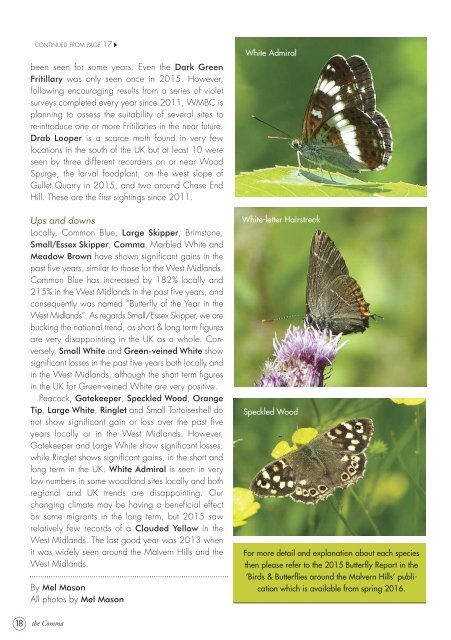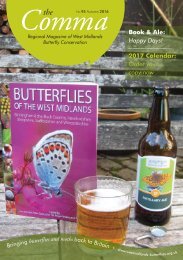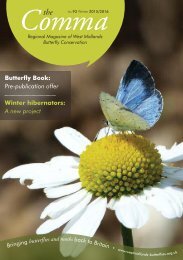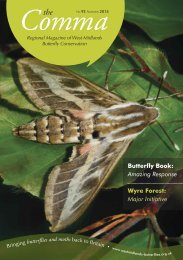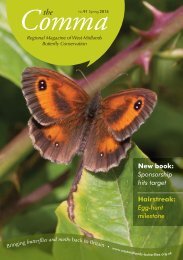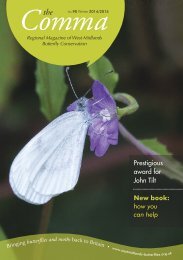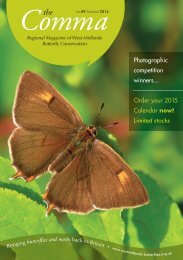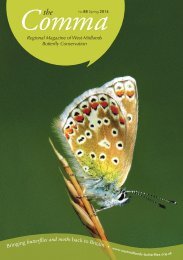Comma No94 Spring 2016
32 page Butterfly Magazine designed for the West Midlands branch of Butterfly Conservation
32 page Butterfly Magazine designed for the West Midlands branch of Butterfly Conservation
You also want an ePaper? Increase the reach of your titles
YUMPU automatically turns print PDFs into web optimized ePapers that Google loves.
CONTINUED FROM PAGE 17<br />
been seen for some years. Even the Dark Green<br />
Fritillary was only seen once in 2015. However,<br />
following encouraging results from a series of violet<br />
surveys completed every year since 2011, WMBC is<br />
planning to assess the suitability of several sites to<br />
re-introduce one or more Fritillaries in the near future.<br />
Drab Looper is a scarce moth found in very few<br />
locations in the south of the UK but at least 10 were<br />
seen by three different recorders on or near Wood<br />
Spurge, the larval foodplant, on the west slope of<br />
Gullet Quarry in 2015, and two around Chase End<br />
Hill. These are the first sightings since 2011.<br />
White Admiral<br />
Ups and downs<br />
Locally, Common Blue, Large Skipper, Brimstone,<br />
Small/Essex Skipper, <strong>Comma</strong>, Marbled White and<br />
Meadow Brown have shown significant gains in the<br />
past five years, similar to those for the West Midlands.<br />
Common Blue has increased by 182% locally and<br />
215% in the West Midlands in the past five years, and<br />
consequently was named “Butterfly of the Year in the<br />
West Midlands”. As regards Small/Essex Skipper, we are<br />
bucking the national trend, as short & long term figures<br />
are very disappointing in the UK as a whole. Conversely,<br />
Small White and Green-veined White show<br />
significant losses in the past five years both locally and<br />
in the West Midlands, although the short term figures<br />
in the UK for Green-veined White are very positive.<br />
Peacock, Gatekeeper, Speckled Wood, Orange<br />
Tip, Large White, Ringlet and Small Tortoiseshell do<br />
not show significant gain or loss over the past five<br />
years locally or in the West Midlands. However,<br />
Gatekeeper and Large White show significant losses,<br />
while Ringlet shows significant gains, in the short and<br />
long term in the UK. White Admiral is seen in very<br />
low numbers in some woodland sites locally and both<br />
regional and UK trends are disappointing. Our<br />
changing climate may be having a beneficial effect<br />
on some migrants in the long term, but 2015 saw<br />
relatively few records of a Clouded Yellow in the<br />
West Midlands. The last good year was 2013 when<br />
it was widely seen around the Malvern Hills and the<br />
West Midlands.<br />
By Mel Mason<br />
All photos by Mel Mason<br />
White-letter Hairstreak<br />
Speckled Wood<br />
For more detail and explanation about each species<br />
then please refer to the 2015 Butterfly Report in the<br />
‘Birds & Butterflies around the Malvern Hills’ publication<br />
which is available from spring <strong>2016</strong>.<br />
18<br />
the <strong>Comma</strong>


